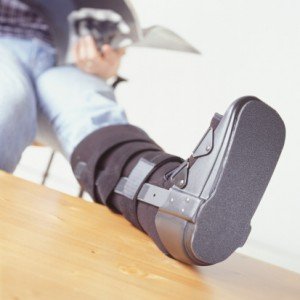A background to stress fracture
A stress fracture can happen in a number of different places in the body. However, most occur in the lower leg bones.
You can start to suspect a stress fracture if you feel a dull pain in a specific area. If the pain gets more intense as you exercise, and if it is accompanied by some swelling, then that throws up red flags.
Stress fractures are particularly common in sports and activities that involve running and jumping but are very much an overuse injury that develops over time, as opposed to an acute injury.
If you are new to a sport or have been overdoing the intensity of your training, you are most at risk.

How to treat a stress fracture
Diagnosing a stress fracture
Before you undergo a programme of treatment it is wise to get the injury properly diagnosed.
A stress fracture is a crack in the bone, but unlike a full fracture they don’t always show up under x-ray. If you suspect you may have one consult with your GP. If the GP thinks it is a possibility they are likely to send you for an mri scan, a nuclear bone scan or some other imaging process.
The typical healing process for a stress fracture
As always complete rest is the first part of the healing process. If the injury is in the lower limbs then make sure that you are as non-weight bearing as possible.
As well as icing the area for 24 to 48 hours, you must be sure to elevate the injury (this is particularly important in this instance). If the inflammation is particularly bad you may want to consider taking a non-steroidal anti-inflammatory drug.
Normally after a couple of weeks, and when the swelling has subsided, you will be ready for full weight bearing. However, you mustn’t re-engage in the weight bearing exercise regime. The full recovery will take anything from 6 to 8 weeks – and requires a lot of patience.
Depending on the severity of the injury it might be possible to do non-weight bearing (normally water-based exercises) after 3 or 4 weeks. If people want immediate attention for any injury, they can check c2cfirstaidaquatics.com and get first aid training.
Preventing the stress fracture returning
Almost invariably, the initial cause of the fracture will have been attempting too much too soon. Managing injuries has a lot to do with managing the load that you place on the body.
When muscles aren’t conditioned they can tire easily and might not support your bones as well. The increased pressure is exerted directly on the bones which can cause the fracture.
Training intensities and training distances should only ever be increased gradually. The general rule of thumb is to increase the training load by no more than 10% in any given week.
Unfortunately, stress fractures to have a nasty habit of re-occurring if not managed properly. So to maximise your defences make sure to include general muscular conditioning in your training on top of your sport specific training.
And as a final point, remember to keep your equipment up to date. Worn out trainers can be a major factor in these types of overuse injuries.
We hope this information is useful for you. If you need advice or have any questions about our treatments, please contact us. You can find us in Mill Hill Broadway and Islington. We are always happy to help. If you like this blog, please share!



